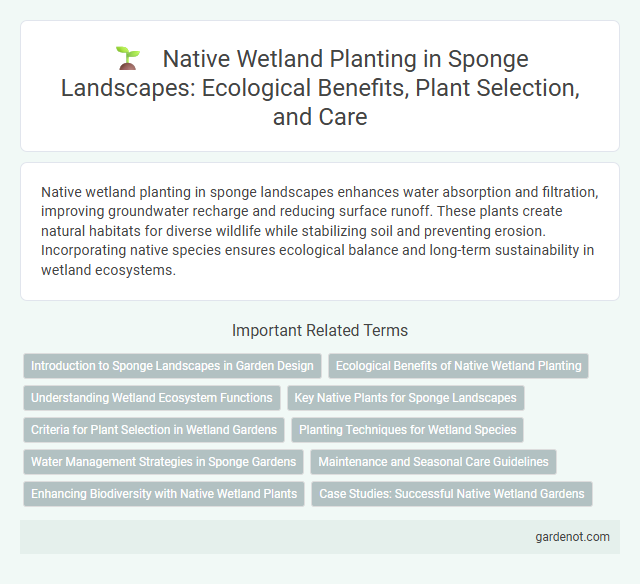Native wetland planting in sponge landscapes enhances water absorption and filtration, improving groundwater recharge and reducing surface runoff. These plants create natural habitats for diverse wildlife while stabilizing soil and preventing erosion. Incorporating native species ensures ecological balance and long-term sustainability in wetland ecosystems.
Introduction to Sponge Landscapes in Garden Design
Native wetland planting enhances sponge landscapes by promoting natural water absorption and filtration, critical in sustainable garden design. Incorporating indigenous wetland plants such as sedges, rushes, and marsh marigolds supports local biodiversity while improving soil permeability and reducing runoff. These plants create resilient ecosystems that mimic natural hydrological cycles, effectively managing stormwater in urban and suburban gardens.
Ecological Benefits of Native Wetland Planting
Native wetland planting enhances biodiversity by providing habitat for diverse species and promoting complex ecosystems. These plants improve water quality through natural filtration, reducing pollutants and stabilizing soil with extensive root systems. Additionally, they support carbon sequestration, mitigating climate change by capturing and storing atmospheric carbon in wetland soils.
Understanding Wetland Ecosystem Functions
Native wetland planting enhances biodiversity by supporting diverse plant and animal species integral to wetland ecosystems. These ecosystems perform essential functions such as water filtration, flood control, and carbon sequestration, which improve environmental resilience. Understanding these functions guides effective sponge landscape design that maximizes ecological benefits while maintaining natural hydrological cycles.
Key Native Plants for Sponge Landscapes
Key native plants for sponge landscapes include species such as Juncus effusus (soft rush), Carex stricta (tussock sedge), and Pontederia cordata (pickerelweed), which enhance water retention and filtration. These hydrophytic plants thrive in saturated soils, supporting biodiversity while reducing surface runoff and promoting groundwater recharge. Incorporating Typha latifolia (broadleaf cattail) and Scirpus validus (softstem bulrush) further strengthens the sponge effect through dense root systems that stabilize soil and improve pollutant breakdown.
Criteria for Plant Selection in Wetland Gardens
Effective native wetland planting in sponge landscapes requires selecting species with high tolerance to periodic flooding and waterlogged soils. Plants must also support local biodiversity, including pollinators and aquatic fauna, while enhancing sediment capture and water filtration. Criteria include root structure for soil stabilization, native adaptability to the specific wetland environment, and resilience to varying moisture levels.
Planting Techniques for Wetland Species
Effective planting techniques for native wetland species involve selecting hydrophytic plants adapted to saturated soil conditions and variable water levels. Utilizing root wads, soil amendments, and proper planting depths enhances plant establishment and resilience in wetland sponge landscapes. Strategic placement of emergent, submergent, and marginal species optimizes water filtration, habitat creation, and flood attenuation.
Water Management Strategies in Sponge Gardens
Native wetland planting enhances sponge gardens by improving water retention and filtration, crucial for sustainable water management strategies. Using indigenous species such as cattails and sedges promotes natural groundwater recharge and reduces flood risks in urban landscapes. This approach supports biodiversity while effectively managing stormwater runoff and maintaining water quality.
Maintenance and Seasonal Care Guidelines
Native wetland planting within sponge landscapes requires regular maintenance to ensure optimal water absorption and habitat function. Seasonal care includes monitoring plant health during dormant periods, removing invasive species, and adjusting water levels to mimic natural wetland fluctuations. Proper upkeep enhances biodiversity, supports native wildlife, and maintains the ecological balance of sponge landscapes.
Enhancing Biodiversity with Native Wetland Plants
Native wetland plants play a crucial role in enhancing biodiversity within sponge landscape systems by providing habitat and food sources for a variety of wildlife species. These plants improve water quality through natural filtration, support soil stabilization, and promote ecological resilience in wetland ecosystems. Integrating diverse native species such as cattails, sedges, and rushes fosters a balanced, thriving habitat that sustains amphibians, birds, and beneficial insects.
Case Studies: Successful Native Wetland Gardens
Native wetland planting projects demonstrate significant ecological benefits by restoring habitat diversity and improving water quality. Case studies such as the Chehalis Basin Wetland Restoration in Washington and the Kissimmee River Restoration in Florida showcase how targeted native species like pickerelweed and swamp milkweed thrive, enhancing native wildlife populations and stabilizing hydrology. These successful native wetland gardens serve as replicable models for sustainable landscape design that supports biodiversity and flood mitigation.
Native wetland planting Infographic

 gardenot.com
gardenot.com